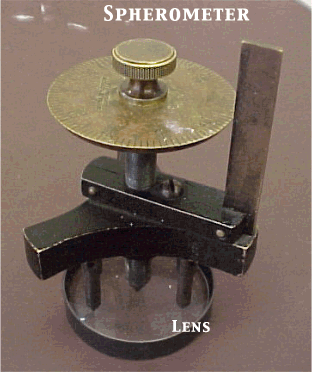Overview:
The focal length of a lens depends on the radii of curvature of the two surfaces of the lens and on the index of refraction of the material (glass or plastic) of the lens. Here is the relationship:
The radius of curvature can be measured with a spherometer:

or with a lens clock:

Goal of this Experiment:
The goal of this experiment is to become familiar with the spherometer and the lens clock and to use these to measure the focal length of several lenses. The measurement with spherometer can be cumbersome, to be sure, but it is accurate. Understanding the accuracy of the final measurement, the focal length, is a nice exercise in error propagation.
You may want to refer to the page on error analysis.
Suggested Procedures:
Using a machinists rule and the spherometer, measure the focal length of a converging lens and a diverging lens. Measure the focal lengths of the same lenses with a lens clock. Compare the measurements. Estimate your measurement errors. Please look at this note on error analysis for this lab (note2.pdf).
Questions:
References: